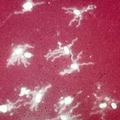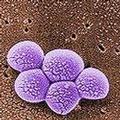 美國德州醫學大學感染性疾病研究員警告,當今世界使用的抗生素遠不及對付千變萬化的病菌,人類的籌碼變少,生命因而飽受超級病菌的威脅。
美國德州醫學大學感染性疾病研究員警告,當今世界使用的抗生素遠不及對付千變萬化的病菌,人類的籌碼變少,生命因而飽受超級病菌的威脅。
莫瑞(Barbara Murray)與亞里亞斯(Cesar Arias)兩位醫學博士於當期的《新英格蘭醫學期刊》,刊載一篇論文評估過去、現在和未來在預防與治療器官感染超級病菌的作法。這些超級病菌的重要特徵就在於對抗生素的抗拒性。
研究員指出,超級病菌會釋放酵素破壞藥性,或是築起一道對抗藥物的防線,藉此避開抗生素的作用。超級病菌甚至能排出病菌細胞中的任何抗生素,或是讓抗生素的目標發生錯亂,以致藥物無法鎖定該病菌。莫瑞表示,「大多數的人都曾聽過『超級金黃色葡萄球菌』(MRSA),因為每年在病歷中總是榜上有名。」「不過僅有極其少數的人認識其他可能會產生更嚴重後果的超級病菌。」
例如,革蘭氏陰性細菌(Gram-negative bacteria)有辦法由細胞壁將毒素釋放至血管中,造成診療上的複雜性增加。而超級金黃色葡萄球菌在美國每年所奪走的生命其至比愛滋病毒還多。
 基因組學是專門研究器官的基因體,刻劃DNA的構成順序。此學科曾被寄託能找出有效的辦法,打擊超級病菌,不過莫瑞與亞里亞斯對此說法態度保留。
基因組學是專門研究器官的基因體,刻劃DNA的構成順序。此學科曾被寄託能找出有效的辦法,打擊超級病菌,不過莫瑞與亞里亞斯對此說法態度保留。
莫瑞與亞里亞斯指出,人們習慣不依處方箋服用抗生素,或甚至在沒在處方的情形下服用,有好有壞,抗生素可以在身體中大範圍地圍剿病菌,不過同時卻也讓體內的病菌有機會發展出對抗抗生素的方法。
大部份的疾病主要是由兩種病菌所致-細菌和病毒。抗生素的作用在於抑制如鏈菌性喉炎(strep throat)的細菌感染。不過若要對付像是一般感冒、流行性感冒、常見的咳嗽與流鼻水等病毒引發的癥狀,則是一籌莫展。
延誤就醫也有關係。莫瑞表示,儘管醫藥再發達,也必須要48小時以上的時間來確認病患的病因,以及據此服用何種抗生素較為有效。 
奧克拉荷馬醫學研究基金會(OMRF)主席普立史考特(Stephen Prescott)認為,「超級黃金葡萄球菌與其他抗抗生素的超級病菌,是今日人類健康的最大威脅」。普氏的論點立基於其研究員於2008年11月時,曾首度以視覺證據,呈現超級病菌中的一塊關鍵拼圖在醫院中如何散播它的抗藥性,並且大規模傳染開來。
德州醫學大學附屬感染性疾病處正努力探究有效的對抗方法。該實驗室目標鎖定由病菌抵抗抗生素的臨床與分子層面著手,試圖了解病菌發展抗藥性的複雜過程,爾後設計出新的策略來殲滅這些所謂的超級病菌。
People are dying from "superbugs" because our antibiotic arsenal has run dry, leaving the world without sufficient weapons to fight the ever-changing bacteria, warn infectious disease researchers at the University of Texas Medical School.
In an article in the current issue of "The New England Journal of Medicine," medical doctors Barbara Murray and Cesar Arias evaluate the past, present and future response to preventing and treating "superbugs," organisms that are resistant to antibiotics.
Superbugs can evade antibiotics by producing an enzyme that destroys the drug or creating a barrier to the drug, the doctors say. Or superbugs can pump out any antibiotic that reaches the bacterial cell or modify the target of the antibiotic so the drug cannot bind to it.
"Most of the public has heard of MRSA [methicillin-resistant Staphylococcus aureus] because it produces the most cases each year," said Murray. "However, they have not heard of other superbugs that can be far worse."
Gram-negative bacteria can release toxins created by their cell walls into the bloodstream, where it is harder to treat them, she said. MRSA appears to be claiming more lives in the United States than HIV/AIDS.
Genomics is the study of an organism's genomes to chart its DNA sequencing. It was once viewed as a possible avenue to better weapons against superbugs, but Murray and Arias say that has not happened.
Murray and Arias say people taking antibiotics without prescriptions or not following their prescriptions as directed allow the antibiotics to be exposed to a wide-range of bacteria in the body, both good and bad, giving the bugs an opportunity to find ways to beat the antibiotic weapons.
Most illnesses are caused by two kinds of germs - bacteria and viruses. Antibiotics work against infections caused by bacteria, like a strep throat. Antibiotics do not work against viruses like the common cold, the flu and the majority of sore throats and runny noses.
Delay in diagnosis is also an issue. Murray said even with advancements, it takes about 48 hours or more from the time a culture is taken to determine what a person may have contracted and to determine what antibiotics are likely to be effective.
"MRSA and other antibiotic-resistant bugs are one of the greatest threats facing health care today," said Stephen Prescott, M.D. president of the Oklahoma Medical Research Foundation, where researchers in November published the first visual evidence of a key piece in the puzzle of how superbugs spread antibiotic resistance in hospitals and throughout the general population.
The Division of Infectious Diseases at the UT Medical School is working toward solutions. The lab aims to investigate the clinical and molecular aspects of antibiotic resistance, attempting to understand the complex mechanisms by which bugs become resistant to antibiotics and then designing new strategies to combat them.


